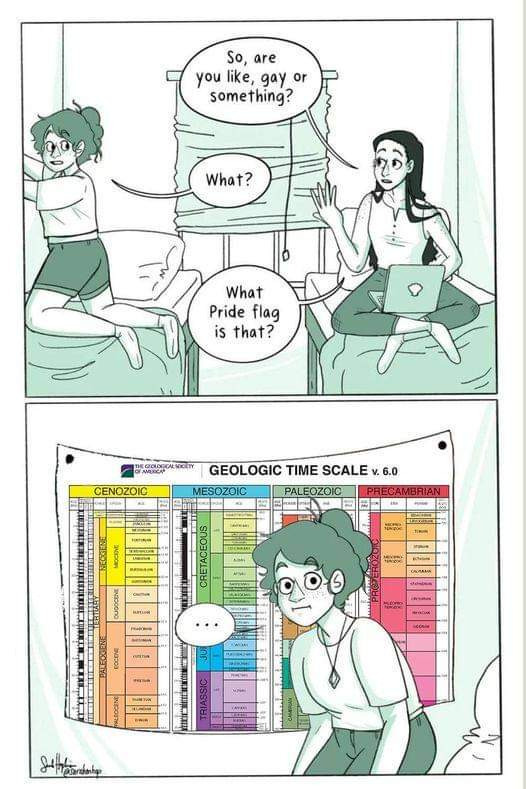#GEOLOGICAL TIME
Text
Once upon a time, there was an enormous landmass called Pangea. Millions of years passed. Continents drifted apart. Single-celled life emerged from a biochemical soup. Photosynthesis arrived on the scene, and eventually, the tree of life began branching out. Prokaryotes and eukaryotes pursued different evolutionary paths.
Unfathomably, life began to organize, to become more complex. Multicellular organisms developed, exploited various ecological niches, and evolved. Early hominids descended from the trees, and as endless generations marched onward, one small branch of life became human. Civilizations rose and fell; millions battled, loved, experienced joy and terror.
Today, you sit there reading these words on an electronic screen. Tomorrow, you'll read more words on screens, and so on into the future, until eventually you die somehow.
Life will march on after you're gone. Your boss will hire someone else. Your descendants, if you have any, will gradually forget about you. You, like countless others before you, will be whisked away into the past.
So maybe chill the fuck out a little.
656 notes
·
View notes
Text
Volcano: Mauna Loa (VNUM #332020)
Current Volcano Alert Level: WARNING
Current Aviation Color Code: RED
Issued: Monday, November 28, 2022, 7:20 AM HST
Source: Hawaiian Volcano Observatory
Notice Number: 2022/H603
Location: N 19 deg 28 min W 155 deg 36 min
Elevation: 13681 ft (4170 m)
Area: Hawaii
Volcanic Activity Summary:
The eruption of Mauna Loa has migrated from the summit to the Northeast Rift Zone where fissures are feeding several lava flows. HVO staff on an overflight at approximately 6:30 a.m. HST confirmed fissures at high elevations within Hawai‘i Volcanoes National Park are feeding lava flows upslope of the Mauna Loa Weather Observatory. Lava flows are not threatening any downslope communities and all indications are that the eruption will remain in the Northeast Rift Zone. Volcanic gas and possibly fine ash and Pele's Hair may be carried downwind.
#Hawai‘i#Mauna Loa#natrual disasters#volcano#geological time#global news#may you be well#may you be safe#may you be free from harm
0 notes
Text
Creative Projects: Dover's History At Night



Work has now moved on to the final piece as the time ticks along and the deadline creeps closer.
I've been busy creating dyed grounds for the 4 Eon names which will form the first layer on top of the base fabric. So far I have sewed applique lettering for the the first Eon: Hadean, and part of the second Eon: Archean. The applique letters are cut from muslin died with tea for both of these eons.
The 2 remaining Eons cover the periods when life burgeoned. So for this I have started dyeing fabric with contact dyeing techniques using leaves and other natural items. These will form the letters for the third Eon: Proterozoic and fourth Eon: Phanerozoic.
I will represent the ratio of the timespan for each of these Eons by how much space they take up on the dress. And I'm using an ancient dress style - 'peplos' - which requires almost zero sewing and no cutting to create the final dress. I may love sewing by hand and happily pass hours embroidering endless words but I have zero skill or patience for dressmaking or tailoring.
A word on the base fabric: it is a found piece - my favourite - in this case an old 100% Egyptian Cotton double sheet of my parents which was then used as a dust sheet for multiple painting and DIY work around the house I grew up in. It has since reclined for over 2 decades in the garage and is beautiful in its own way - the marks and spots and drips and rips themselves telling the story of all the years and happenings the sheet has seen.
#textiles#dresses#embroidery#memory#family history#autoethnography#hand dyeing#applique#Dover At Night#Installation#geology#geological time
0 notes
Text

Geologic Time Chart. Guide for beginning fossil hunters. 1959.
Internet Archive
#geologic time#scientific illustration#chart#charts#processed image#red#paleontology#nemfrog#1959#1950s
2K notes
·
View notes
Text
Thousands of years are an instant in geological time. It’s perfectly justified to think that climate change will cause the apocalypse in my lifetime, and the Industrial Revolution started the planet down that path mere centuries ago. I say “mere centuries” even though a single year is exceptionally long because in geological time, humans as a species will have destroyed the planet in LESS THAN AN INSTANT.
#climate change#global warming#apocalypse#climate apocalypse#climate change apocalypse#geological time#geologic time
1 note
·
View note
Photo

“Confirm Age of the Earth At 3,000,000,000 Years,” Kingston Whig-Standard. October 18, 1932. Page 1.
----
TORONTO, Oct. 18 — Two Toronto scientists by means of their experiments claim today to have confirmed the age of the earth at three thousand million years.
Professor X. F. Burton, chairman cf the physics department at the University of Toronto and Professor J. C. McLennan claim that experiments with liquefied helium in glass vacuum bottles confirm deductions from analyses of radio-active rocks.
#toronto#university of toronto#physicists#radiometric dating#radioactive dating#radioisotope#liquid helium#age of the earth#geological time#deep time#great depression in canada
1 note
·
View note
Text

I had to lol.
Mikuceratops!! Based off Medusaceratops :D
#art#my art#paleoart#paleontology#science#illustration#dinosaur#hatsune miku#ceratopsian#medusaceratops#mikuceratops#meme#miku worldwide#international miku#miku across geologic time#vocaloid miku#miku#miku fanart
220 notes
·
View notes
Text



finally got the tattoo of my dreams <3
#it’s the geologic time scale!!#since im going back to school to (hopefully) finish my bachelors in geo this fall 🥹#geology#tattoos#rambles#im soooooo happy w it you have no idea I’ve been dreaming about this for YEARS
272 notes
·
View notes
Note
Thought you would enjoy :)

By: @zoe248
It me!
149 notes
·
View notes
Text
youtube
Life on Our Planet trailer dropped!
#life on our planet#love how many creatures from how many different periods it's showing#i hope there's enough time to cover such a breadth of geologic history#Youtube
94 notes
·
View notes
Text

Chart with PhyloPic silhouettes from an essay in the upcoming comic book, Paleocene #4. These are lineages that survived the Cretaceous–Paleogene extinction event but died out before the Holocene Epoch (which is almost too brief to be visible here—it is a thin sliver atop the Pleistocene). Figures are not to scale, and do not line up perfectly to lineage extinction dates, just to epochs. This chart is available under the CC BY-SA 3.0 license.
For more information about the silhouettes in the chart, see: https://www.phylopic.org/.../7dc1ae186d11d8c2ad9f502fc47d...
For more about the comic book, see https://www.kickstarter.com/projects/keesey/paleocene-4-comic-book
#extinction#paleontology#dinosaur#paleoart#palaeontology#prehistoric#biology#zoology#botany#extinct animals#extinct species#extinct birds#cenozoic#sciart#palaeoblr#deep time#geologic time
73 notes
·
View notes
Text
It's very frightening that most deserts are just seas that you missed.
#brrrrrrr#geological time is terrifying#'hi this used to be a beach'#'this was an island'#'this was just a rock with'
121 notes
·
View notes
Text
i love how hgsn has just become Yoshiki’s independent research project with the occasional ghost roadblock
#Our next enemy will be Yoshiki’s pencil breaking while he’s in the middle of a sentence!#hikaru ga shinda natsu#the summer hikaru died#hgsn#my hgsn shit#I’ll need about 5 maps of varying styles (political; topographical; geologic; physical; and maybe a resource map)#And 7 more flow charts and a comprehensive time line before I truly understand what’s going on#How many mountains are there again
23 notes
·
View notes
Text
WORD OF THE DAY
Geologic time noun. The time covering the physical formation and development of the earth, esp. Prior to human history.

#webster's new college dictionary (3rd edition)#webster's new college dictionary#definition#geologic time#geology#diagram
5 notes
·
View notes
Text
youtube
S2.8 is now on YouTube!
Have you ever thought about how dinosaurs lived on a warm, swampy Earth and how we live on one that’s cold enough to keep pretty much the entirety of Greenland and Antarctica buried under kilometers-thick sheets of solid ice and wondered, hmm, how did we get from there to here? The short answer is that it took 50 million years of declining atmospheric carbon dioxide concentrations and dropping temperatures, not to mention building an ice sheet or two.
For the longer story of the last 50 million years of climate change, including some of the reasons why, catch this episode of our podcast with Dr De La Rocha! You’ll hear about plate tectonics and continental drift, silicate weathering, carbonate sedimentation, and the spectacular effects the growth of Earth’s ice sheets have had on Earth’s climate. There are also lessons here for where anthropogenic global warming is going and whether or not its effects have permanently disrupted the climate system. Fun fact: the total amount of climate change between 50 million years ago and now dwarfs what we’re driving by burning fossil fuels, and yet, what we’re doing is more terrifying, in that it’s unfolding millions of times faster.
Bonus content: If you want to see sketches and plots of the data discussed in this episode, you can do so at our website here!!
Nerd alert!! If you're interested in the primary scientific literature on the subject, these four papers are a great place to start:
Dutkiewicz et al (2019) Sequestration and subduction of deep-sea carbonate in the global ocean since the Early Cretaceous. Geology 47:91-94.
Müller et al (2022) Evolution of Earth’s plate tectonic conveyor belt. Nature 605:629–639.
Rae et al (2021) Atmospheric CO2 over the last 66 million years from marine archives. Annual Review of Earth and Planetary Sciences 49:609-641.
Westerfeld et al (2020) An astronomically dated record of Earth’s climate and its predictability over the last 66 million years. Science 369: 1383–1387.
#carbonate sedimentation#silicate weathering#solarpunk#solarpunk podcast#Solarpunk Presents Podcast#Dr Christina De La Rocha#plate tectonics#deep time#climactic system#climate change over millions of years#biogeochemical cycles#biogeochemistry#geological analysis of climate change#carbon dating#global warming#earth sciences#history of climate change#archaeology of climate change#continental drift#what was the climate like for the dinosaurs#youtube#Youtube
7 notes
·
View notes